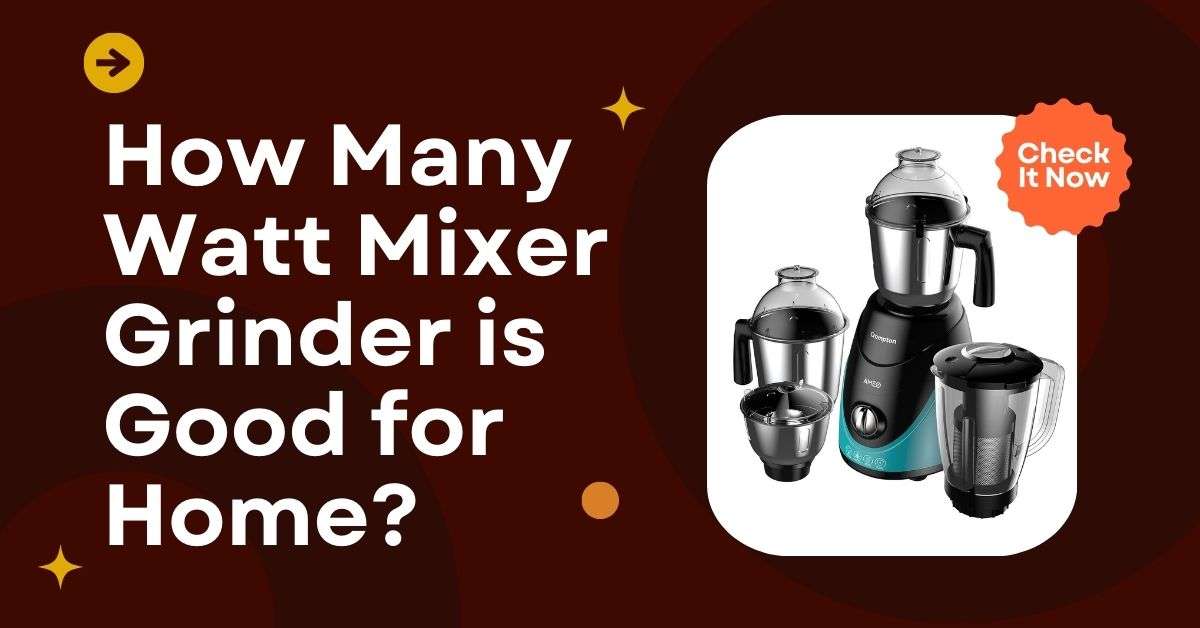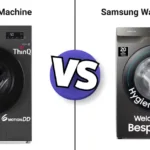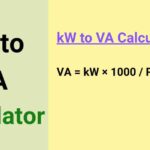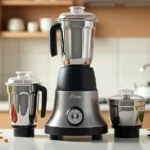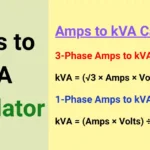Choosing the right wattage for your mixer grinder can make a lot of difference in your cooking experience at home.
This article will explore how many watt mixer grinder is good for home use, so you can get it right.
Whether you crush spices, prepare chutneys, or whip up a smoothie, the wattage of your mixer grinder affects its performance and efficiency.
At the end of this tutorial, you will be able to identify what wattage is appropriate for different household activities and why it should matter to you.
As an active homemaker, knowing what to look out for will save you time and money which translates into better outcomes from your kitchen.
Let’s discuss the most suitable wattage that will do wonders in your culinary journey with a grinder!
Also read: Mixer Grinder Blade Types And Uses.
Understanding How Many Watt Mixer Grinder is Good for Home?
What is Wattage?
Mixer grinders have a wattage that signifies the power consumed by the motor in such a device.
The higher the wattage, the more powerful the motor of a mixer grinder.
In other words, if you have to break down tough ingredients like hard spices or thick mixtures it will be easier for you because they can be easily done with this machine.
Higher wattage levels translate into stronger mixer grinders that can cope with demanding kitchen tasks effectively.
Total wattage represents a mixer’s overall grinding and blending capability and strength.
Importance of Wattage in Mixer Grinders.
#1. How Wattage Impacts Performance and Functionality:
Wattage has a great effect on how well a mixer grinder will work.
A powerful motor can handle even the toughest ingredients and heavy-duty grinding/blending tasks at full speed without slowing down or overheating.
As a result of this, grinding is smoother, processing time is reduced and every recipe is possible without stress.
However, low wattage may not allow your mixer grinder to do some harder jobs efficiently so might end up with uneven results too maybe working slower than usual as well as uneconomically for you sometimes.
#2. The Correlation Between Wattage and Food Processing Tasks:
Different wattage ranges are better suited for different kinds of grinding and blending tasks:
#3. Low Wattage (Up to 500 Watts):
It works best for things like chutneys, purees, or soft spice groundings that are less challenging to perform using it.
But using it occasionally not intensively and mainly in smaller families.
#4. Medium Wattage (500 to 750 Watts):
For regular utilization with stronger cooking materials such as nuts, which need pastes or batters to be produced out of them whenever needed.
This one may be fitting for an average household that isn’t too big-sized.
#5. High Wattage (Above 750 Watts):
The best thing about this is that it is suitable for heavy-duty, grinding rock-hard spices, meat, or blending thick mixtures.
It would do well in a large family setting or among individuals who cook often and need an all-purpose utility able to handle anything they throw its way.
Also read: Best Bajaj Mixer Grinder 750 Watt In India.
What Factors Should You Consider When Choosing Mixer Grinder Wattage?
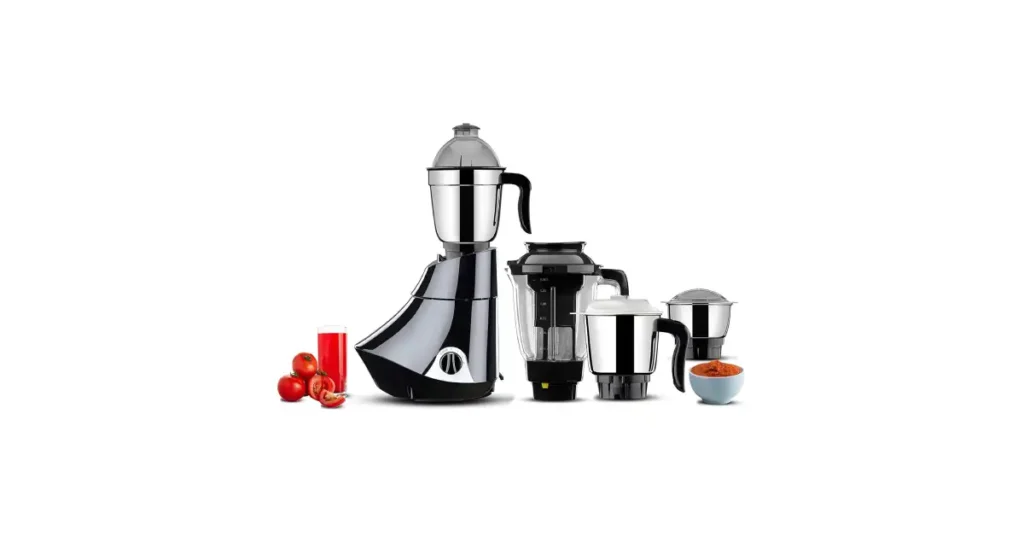
#1. Frequency of Use.
Consider how much you use the mixer grinder and what you typically use it for.
If you are using it every day for various purposes such as spice grinding, paste making or smoothies blending higher wattage (500-750 watts) will be more appropriate.
For occasional use like making chutneys or purees once in a while, lower wattage (up to 500 watts) will do.
#2. Type of Ingredients.
Consider the kind of ingredients that you usually process.
Soft items like tomatoes herbs and mild spices don’t require much power so a lower-wattage mixer grinder can easily manage them.
However, if you often grind hard stuff like nuts, seeds, or strong spices then you will have to go for a higher wattage (750 watts or more) to ensure efficient processing which is smooth all the time.
#3. Family Size.
This is also influenced by the number of people in your family and how much food you make.
Small families require mixers that have power capacities not exceeding 500 watts.
However, for medium to large families with a lot of food to be processed, it would be more desirable to use higher wattage (500-750 watts).
In this regard, it is important to have a mixer grinder that can take up these heavy duties without easily wearing out or heating up.
Also read: How To Fix Your Mixer Grinder Overload Switch Not Working.
What are the Pros and Cons of Different Mixer Grinder Wattages?
#1. Lower Wattage Mixers (Up to 500 Watts).
Pros
- This helps in reducing the amount of electricity used and hence saving on energy costs.
- Sometimes lower wattage models are sold at lower prices than those requiring high wattage.
- They are noisier during operation.
Cons
- These are best suited for simple tasks such as making purees and chutneys.
- if you want to grind very hard nuts or spices, they may not work well for you.
#2. Medium Wattage Mixers (500 to 750 Watts)
Pros
- They can do anything from spice grinding to batter-making.
- It’s ideal for an average-sized family that uses them daily on a normal routine basis.
Cons
- Uses more electricity compared to lower-wattage options.
- Relatively more money initially due to its increased capacity and power.
#3. High Wattage Mixers (Above 750 Watts)
Pros
- Handles tough jobs like pounding hard spices, nuts, and thick pastes.
- with ease Made either frequently or heavily so they last long.
Cons.
- Consumes too much electricity thus raising energy bills.
- Strong motor and advanced features increase the initial cost to be high.
- It is noisier when in operation as a result of this strong motor.
Also read: Prestige Endura PRO Mixer Grinder.
What are Some Tips for Maintaining Your Mixer Grinder?
#1. Regular Cleaning and Care Tips.
- Always clean out the jars, blades, and lids after use to stop food from drying up and sticking to them.
- Use mild dish soap and warm water to wash both jars and blades. Any chemicals that can cause damage so should not be used.
- Make sure all parts are completely dry before reassembling to avoid rusting or bacterial growth.
- For stubborn stains, mix baking soda with water. Spread some of it onto the affected region then let it sit for minutes before scrubbing gently followed by thorough rinsing.
#2. Best Practices for Extending the Life of Your Mixer Grinder.
- Do not overload the jar beyond its capacity or operate the mixer grinder continuously for long periods. Overloading may strain its engine thus shortening its life cycle.
- Use a pulse setting instead to avoid overheating the motor during a brief burst of activity only.
- Keep blades sharp and well-maintained; otherwise pressing will take greater effort and burden your device further with hard usage again on blunt edges, which would deteriorate their shape within a short period too now!
- Choose suitable jars as well as blades to run efficiently without any harm occurring to them due to that action performed.
- When cooking using a mixer grinder you should give it some break between every task to prevent overheating.
#3. Safety Precautions to Follow.
- Ensure the jars and lids are tightly closed before turning on the mixer grinder.
- Ensure the jars and lids are tightly closed before turning on the mixer grinder.
- Always disconnect the mixer grinder from a power source when not in use or when cleaning.
- Since blades are sharp, they should be handled with care to avoid causing injuries of any kind.
- Users must adhere to the manufacturer’s instructions as provided in their user manuals to ensure safety and optimum performance.
Also read: Crompton AMEO Pro.
FAQs
Which is better mixer grinder 750 watts or 1000 watts?
The principal distinction between them is in power and heavy-duty performance. If you grind tough ingredients often or want to make large quantities of food regularly, 1000-watt mixer grinders are an ideal option for you since they contain more strength. Its extra brawn will enable it to take on the most demanding chores at faster rates without getting tired easily. However, for everyday household use as well as simple grinds, a 750-watt model does just fine and also saves energy consumption. Think about how intensely it is used: if it’s only occasionally for chutneys and batters, then 750 watts are sufficient; but when there are thousands of heavy grinding ahead, the 1000-watt alternative may be worth considering.
Which mixer grinder is good, 500 watt or 750 watt?
The two models include a more powerful one which is the 750-watt. This additional wattage enables them to handle much harder ingredients such as harder nuts or grind bigger quantities at once without losing their efficiency either. Therefore, if you do big-volume grinding regularly or cook some challenging recipes using your mixer grinder, the better choice would be a 750-watt mixie. It has got a 500-watt that performs great for light occasional like making sauces and purees but not so well when it comes to regular heavy-duty grinds where it could slow down sometimes. Take into account what you generally use – the extra power and flexibility offered by the 750-watt will suffice for you.
How many watts is good for grinder?
Wattage requirements are slightly different when it comes to grinding only. There is no problem grinding small amounts of spices or making chutneys using a 500-750 watt grinder however, if you grind large quantities regularly or ingredients as hard as grains and hard spices, go for a grinder with 750 watts or higher wattage. It should have more power to deal with the heavy grinds that occur during its usage and at the same time it should not lose its efficiency by overheating. The intensity and scale of your grinding needs inform the wattage an exclusive grinder should be fitted with.
Is higher watts better for mixers?
Not true! Though high wattage means more capacity for handling tough grinds, it also results in greater energy consumption. The best wattage will depend on your unique requirements and how you use the appliance every day. Sometimes too, high levels of electrical power might be unnecessary especially when one does occasional mild grinding which justifies settling on low-cost models that do not consume much electricity as such. However, if you find yourself having to grind huge amounts frequently or even tough things that are being done away with; then this extra cost may turn into savings through increased efficiencies brought about by higher wattages. So what do I mean? Consider carefully the types of grinding and blending work that you think you’ll be doing most often – then select a corresponding level of watts without overdoing them thereby wasting energy. Careful balance is everything here!
Conclusion.
The power of your mixer grinder must be selected at an optimum level for better results.
Proper selection of wattage can be determined by how often you use it, the type of materials used, and family size per serving; if these factors are neglected the performance will never be satisfying.
How frequently you cook and what you like cooking should be taken into account before buying anything instead of realizing later that what was bought doesn’t match your style or taste.
To know more about how many watt mixer grinder is good for home, check here for our comprehensive buying guides and reviews.
